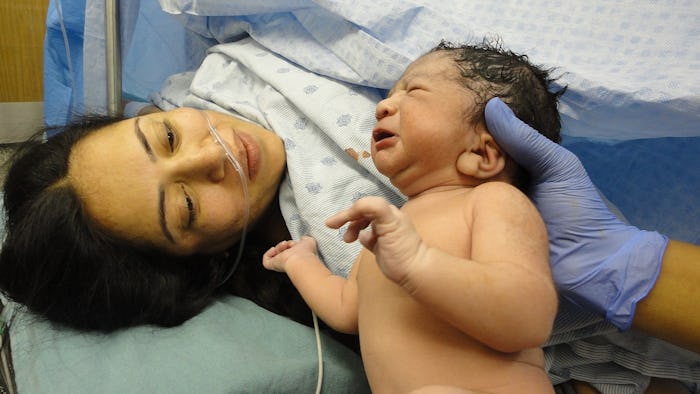Depending on which camp you fall into, C-sections are either the worst form of child birth or a magical gift designed to make the process a lot easier for moms. If you are trying to decide whether or not a cesarian section is in your birth plan, you should know the facts regarding all of the myths about C-sections floating around in the mamasphere (and, obviously, the internet.)
Some believe that women who opt to have a C-section are taking the easy way out; avoiding the pain and making labor fit within their predetermined timeline. Others view the procedure as a last resort, to be used only when it is necessary for the safety of mother and child. But there's no denying the growing popularity of delivery by cesarian, According to The Huffington Post, more than 32 percent of births occurred by C-section in 2013, which was greater than the 10 to 15 percent medically necessary target recommended by the World Health Organization.
Although there are risks and benefits associated with both vaginal and cesarian births, it's important to know that having a C-section does not have to impact your ability to bond with your baby.
While you're waiting for your little one to arrive, take a few minutes to learn about some of the myths around C-sections, so you can your family can be prepared for any situation.
Myth #1: It's Better To Schedule A C-Section When You're Past Due Than To Induce
You might think that scheduling a C-section is an easier and less painful path to take than a labor induction when your due date has come and gone. But that is not always the case. As a general rule, there are fewer chances for complications with a vaginal birth than with a cesarean, according to Health.
Myth #2: You Will Have Trouble Breastfeeding If You Deliver Via C-Section
As Shilpi S. Mehta-Lee, assistant professor of Maternal Fetal Medicine at NYU Langone Medical Center told The Huffington Post, a woman's method of delivery does not impact their ability to breastfeed. If you are unable to start nursing in the operating room, your doctors will have you start once you're settled into recovery.
Myth #3: C-Sections Aren't Painful
You may not feel any pain while on the operating table, but to say that a C-section is painless would be completely false. According to The Huffington Post, women who have undergone C-sections will feel pain for at least two weeks after the procedure.
Myth #4: You Won't Be Able To Photograph Anything
You don't have to miss out on those beautiful birth photos just because you are having a C-section. According to The Huffington Post, there are photographers are available to capture your baby's first moments.
Myth #5: You Won't Be Able To Have Skin-To-Skin Contact After A C-Section
Skin-to-skin contact between mother and baby after birth has been proven to help stabilize baby's breathing and temperature. But this can be difficult to accomplish after a C-section. According to The Stir, moms-to-be should ask their doctor about the hospital's policies on skin-to-skin contact after delivery while preparing their birth plan. Some hospitals will have nurses on hand in the operating room to facilitate the process.
Myth #6: You Can Schedule Your C-Section When You're Tired Of Being Pregnant
If you're trying to As mentioned on Scary Mommy, the American Congress of Obstetricians and Gynecologists does not approve of doctors scheduling C-sections before week 39 except in situations which are life-threatening to mother or baby.
Myth #7: You Can't Delivery Vaginally After Having A C-section
It was once believed that if you've had one delivery by C-section that every pregnancy thereafter would have to result in a C-section. Today, women and their doctors can work together to determine the safest option for both mother and baby. According to the American Congress of Obstetricians and Gynecologists, the decision to perform a VBAC (Vaginal Birth After Cesarian) is based on a number of factors including the type of incision the mother had in the previous procedure, the number of C-sections she's had, and whether or not she has any medical conditions that would make a vaginal delivery unsafe.
Myth #8: You'll Be Completely Unconscious During Your Procedure
You won't sleep through the process. According to WebMD, an epidural is used for pain management during a C-section procedure. General anesthesia is only used in emergency situations.
Myth #9: Having An Epidural Makes A C-Section Inevitable
Although an epidural can make the labor process take a little longer, it doesn't have to mean a trip to the operating room. According to The Bump, there is no evidence of an increase in cesarian births for women who receive an epidural in the hospital.
